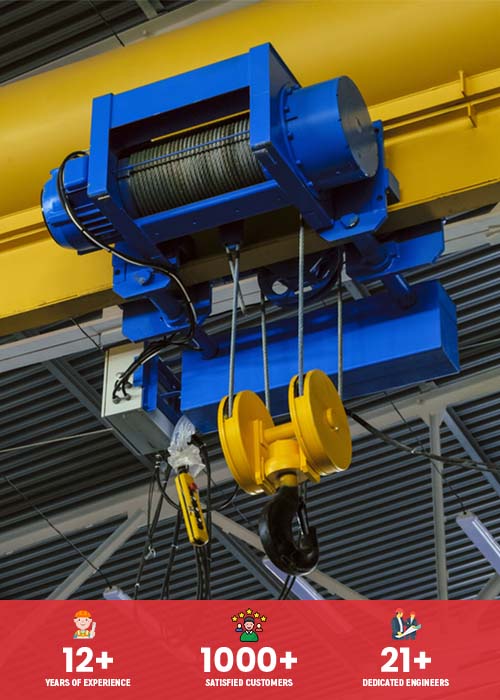EOT Crane vs HOT Crane: What’s the Difference and Which One Do You Need?
When it comes to material handling equipment in industries, cranes play a vital role in ensuring efficiency, safety, and productivity. Among the most common types, EOT cranes (Electric Overhead Traveling cranes) and HOT cranes (Hand Operated Traveling cranes) are widely used in factories, warehouses, and workshops. Both serve the same purpose i.e lifting and moving heavy loads, but their mechanisms, operations, and applications differ significantly. Understanding these differences is essential for making the right investment that suits your business needs.
In this article, we will explore the key differences between EOT cranes and HOT cranes, their advantages, limitations, and how to decide which one is the right choice for your facility depending upon the specific requirements.
What is an EOT Crane?
An EOT crane (Electric Overhead Traveling crane) is a type of overhead crane that operates using electricity. It is mounted on a pair of parallel runways and can move both horizontally and vertically to lift heavy loads efficiently. These cranes are fully motorized, making them suitable for industries that require frequent and heavy lifting tasks.
EOT cranes are available in single girder and double girder variants, depending on the load capacity and application. They are widely used in sectors such as construction, steel plants, manufacturing, automobile, and logistics because of their automation, precision, and ability to handle heavy-duty operations.
What is a HOT Crane?
A HOT crane (Hand Operated Traveling crane) is also an overhead crane, but instead of electricity, it is manually operated using a hand chain or geared mechanism. Unlike EOT cranes, HOT cranes do not rely on motors, making them simpler in design and operation.
Since they are hand-operated, HOT cranes are generally used in smaller workshops, machine shops, or industries where the load requirement is relatively low. They are cost-effective and easy to maintain, making them a suitable choice for businesses that have budget constraints but still require efficient load handling.
Major Differences Between EOT Crane and HOT Crane
Below are some of the major differences between these two types of cranes:
Power Source
EOT Crane: Runs on electricity with motorized operations.
HOT Crane: Operated manually using a hand-driven mechanism.
Load Handling Capacity
EOT Crane: Suitable for heavy-duty loads ranging from a few tons to hundreds of tons.
HOT Crane: Ideal for lighter loads, typically used for weights up to a few tons.
Speed and Efficiency
EOT Crane: Faster, precise, and efficient for high-volume lifting tasks.
HOT Crane: Slower due to manual operation, making it less efficient for frequent use.
Applications
EOT Crane: Found in industries like steel plants, shipyards, warehouses, and construction sites.
HOT Crane: Common in smaller workshops, maintenance shops, and machine rooms.
Cost
EOT Crane: Higher initial investment due to automation and motorized systems.
HOT Crane: Cost-effective and affordable for small businesses.
Maintenance
EOT Crane: Requires regular maintenance of electrical and mechanical parts.
HOT Crane: Simple design leads to lower maintenance costs.
Operator Skill Requirement
EOT Crane: Requires trained operators to ensure safe and efficient use.
HOT Crane: Easy to use, requires minimal training.
Advantages of EOT Cranes
- Can handle very heavy loads.
- Operates with precision and consistency.
- Saves time due to motorized control.
- Improves safety by minimizing manual handling risks.
- Suitable for continuous, large-scale industrial operations.
Advantages of HOT Cranes
- Low cost compared to EOT cranes.
- Simple design and easy to install.
- Minimal maintenance required.
- Does not depend on electricity. Ideal for places with power constraints.
- Perfect for light-duty lifting tasks in small industries.
Which Crane Do You Need?
The decision between an EOT crane and a HOT crane depends on the nature of your business operations, budget, and load requirements.
- If your industry deals with large-scale production, heavy machinery, or frequent lifting tasks, an EOT crane is the best choice. It provides speed, automation, and long-term efficiency.
- If your workshop or business involves occasional lifting of lighter loads and budget is a key consideration, then a HOT crane is more suitable. It offers reliability without requiring significant investment.
In short, if you are looking for performance and automation, go for an EOT crane. If you are seeking affordability and simplicity, a HOT crane will serve your purpose.
Conclusion
Both EOT and HOT cranes have their own significance in industrial operations. While EOT cranes are advanced, powerful, and ideal for heavy-duty tasks, HOT cranes remain practical and economical for smaller setups. Before making a decision, it’s important to evaluate your load requirements, operational frequency, and long-term goals.
If you are planning to invest in advanced lifting solutions, choosing the right EOT crane manufacturer in India will ensure that you get durable, safe, and efficient equipment customised to your specific needs.




